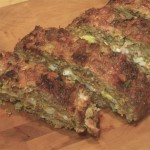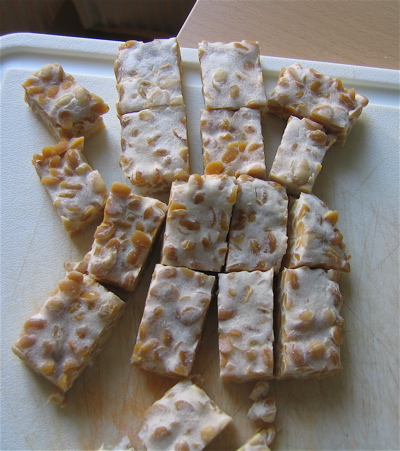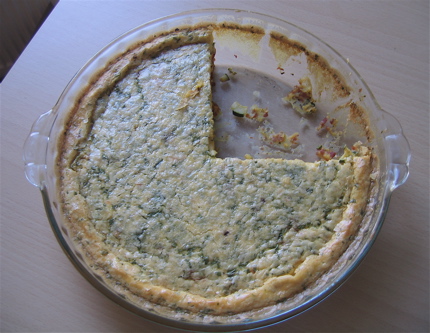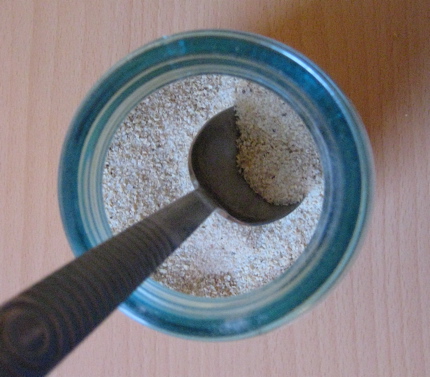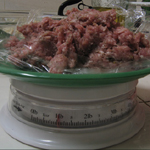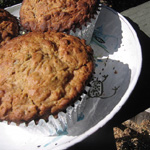Danish Braid with Nectarine & Strawberry Butter Filling
This month I joined the Daring Bakers! After drooling over the opera cake at Sugarlaws and Feeding Maybelle last month, I decided I would throw my hat into the ring and learn to bake something new.
And then…. I read this month’s challenge and questioned my decision — a Danish Braid? laminated dough? ahhh! too hard! too hard! Anyhow, once I got over my initial trepidation, I got to baking, and bake I did!
Well, I guess I’m going to toot my own horn, because WOW — my Danish Braids turned out GREAT! The dough was flaky, light, and perfectly golden brown when it came out of the oven. Steven even deemed them ‘the best thing I’ve ever made‘!
The traditional filling is made from apples and vanilla, but since apples won’t be in season until the fall, I decided to go with a filling that reflects what is bountiful at the farmer’s market these days. I had five early-season nectarines floating around my kitchen, so i decided to use those as the base for the filling. It was my original intention that the filling would be entirely nectarine, but I came up woefully short of the three cups of diced fruit I needed for the nectarine butter. So what to do?? Strawberries to the rescue! Added to the nectarines, they made a delicious fruit butter. Next time I would probably add more nectarines than strawberries, perhaps 2 to 1, or even more, as the nectarine flavor was a little masked by the vibrant berries, but overall, I certainly enjoyed the combination.
Anyhow, hundreds (perhaps thousands) of blogging foodies/bakers will be posting their versions of the Danish Braid today — I encourage you to check them out! I centralized list of the daring bakers can be found at the Daring Baker’s Blogroll.
Nectarine and Strawberry Butter
* * * * * * * * * * * * * * * * * * * *
Nectarine & Strawberry Butter
Based on Nectarine Butter recipe from Rosey’s Preserves5 small nectarines, pitted, chopped to make about 1.5 c
1 1/2 c. + 1/2 c. diced strawberries
1 1/4 c. sugarCombine nectarines, 1 1/2 c. strawberries, and sugar in a heavy saucepan. Cook at a gentle boil at medium heat for 1 hour 15 minutes, stirring occasionally.
Take the pot off the stove and puree mixture with a hand blender until very smooth.Cook another 25-30 minutes, stirring often, making sure that mixture does not burn on the bottom. The butter will be ready when you place a small amount on a plate and no water seeps out. It should be rich, smooth and dark. Mix in additional 1/2 c. strawberries. Butter will keep for at least one week.
Note: if you would like to can the butter, omit the additional fresh strawberries, fill jars, and process according to manufacturer’s directions.
* * * * * * * * * *
DANISH DOUGH
Makes 2-1/2 pounds doughIngredients
For the dough (Detrempe)
1 ounce fresh yeast or 1 tablespoon active dry yeast
1/2 cup whole milk
1/3 cup sugar
Zest of 1 orange, finely grated
3/4 teaspoon ground cardamom
1-1/2 teaspoons vanilla extract
1/2 vanilla bean, split and scraped
2 large eggs, chilled
1/4 cup fresh orange juice
3-1/4 cups all-purpose flour
1 teaspoon saltFor the butter block (Beurrage)
1/2 pound (2 sticks) cold unsalted butter
1/4 cup all-purpose flourDOUGH
Combine yeast and milk in the bowl of a mixer fitted with the paddle attachment and mix on low speed. Slowly add sugar, orange zest, cardamom, vanilla extract, vanilla seeds, eggs, and orange juice. Mix well. Change to the dough hook and add the salt with the flour, 1 cup at a time, increasing speed to medium as the flour is incorporated. Knead the dough for about 5 minutes, or until smooth. You may need to add a little more flour if it is sticky. Transfer dough to a lightly floured baking sheet and cover with plastic wrap. Refrigerate for 30 minutes.Without a standing mixer: Combine yeast and milk in a bowl with a hand mixer on low speed or a whisk. Add sugar, orange zest, cardamom, vanilla extract, vanilla seeds, eggs, and orange juice and mix well. Sift flour and salt on your working surface and make a fountain. Make sure that the “walls” of your fountain are thick and even. Pour the liquid in the middle of the fountain. With your fingertips, mix the liquid and the flour starting from the middle of the fountain, slowly working towards the edges. When the ingredients have been incorporated start kneading the dough with the heel of your hands until it becomes smooth and easy to work with, around 5 to 7 minutes. You might need to add more flour if the dough is sticky.
BUTTER BLOCK
1. Combine butter and flour in the bowl of a mixer fitted with a paddle attachment and beat on medium speed for 1 minute. Scrape down the sides of the bowl and the paddle and then beat for 1 minute more, or until smooth and lump free. Set aside at room temperature.
2. After the detrempe has chilled 30 minutes, turn it out onto a lightly floured surface. Roll the dough into a rectangle approximately 18 x 13 inches and ¼ inch thick. The dough may be sticky, so keep dusting it lightly with flour. Spread the butter evenly over the center and right thirds of the dough. Fold the left edge of the detrempe to the right, covering half of the butter. Fold the right third of the rectangle over the center third. The first turn has now been completed. Mark the dough by poking it with your finger to keep track of your turns, or use a sticky and keep a tally. Place the dough on a baking sheet, wrap it in plastic wrap, and refrigerate for 30 minutes.
3. Place the dough lengthwise on a floured work surface. The open ends should be to your right and left. Roll the dough into another approximately 13 x 18 inch, ¼-inch-thick rectangle. Again, fold the left third of the rectangle over the center third and the right third over the center third. No additional butter will be added as it is already in the dough. The second turn has now been completed. Refrigerate the dough for 30 minutes.
4. Roll out, turn, and refrigerate the dough two more times, for a total of four single turns. Make sure you are keeping track of your turns. Refrigerate the dough after the final turn for at least 5 hours or overnight. The Danish dough is now ready to be used. If you will not be using the dough within 24 hours, freeze it. To do this, roll the dough out to about 1 inch in thickness, wrap tightly in plastic wrap, and freeze. Defrost the dough slowly in the refrigerator for easiest handling. Danish dough will keep in the freezer for up to 1 month.DANISH BRAID
Makes enough for 2 large braidsIngredients
1 recipe Danish Dough (see below)
2 cups apple filling, jam, or preserves (see above)For the egg wash: 1 large egg, plus 1 large egg yolk
1. Line a baking sheet with a silicone mat or parchment paper. On a lightly floured surface, roll the Danish Dough into a 15 x 20-inch rectangle, ¼ inch thick. If the dough seems elastic and shrinks back when rolled, let it rest for a few minutes, then roll again. Place the dough on the baking sheet.
2. Along one long side of the pastry make parallel, 5-inch-long cuts with a knife or rolling pastry wheel, each about 1 inch apart. Repeat on the opposite side, making sure to line up the cuts with those you’ve already made.
3. Spoon the filling you’ve chosen to fill your braid down the center of the rectangle. Starting with the top and bottom “flaps”, fold the top flap down over the filling to cover. Next, fold the bottom “flap” up to cover filling. This helps keep the braid neat and helps to hold in the filling. Now begin folding the cut side strips of dough over the filling, alternating first left, then right, left, right, until finished. Trim any excess dough and tuck in the ends.Egg Wash
Whisk together the whole egg and yolk in a bowl and with a pastry brush, lightly coat the braid.Proofing and Baking
1. Spray cooking oil (Pam…) onto a piece of plastic wrap, and place over the braid. Proof at room temperature or, if possible, in a controlled 90 degree F environment for about 2 hours, or until doubled in volume and light to the touch.
2. Near the end of proofing, preheat oven to 400 degrees F. Position a rack in the center of the oven.
3. Bake for 10 minutes, then rotate the pan so that the side of the braid previously in the back of the oven is now in the front. Lower the oven temperature to 350 degrees F, and bake about 15-20 minutes more, or until golden brown. Cool and serve the braid either still warm from the oven or at room temperature. The cooled braid can be wrapped airtight and stored in the refrigerator for up to 2 days, or freeze for 1 month.
